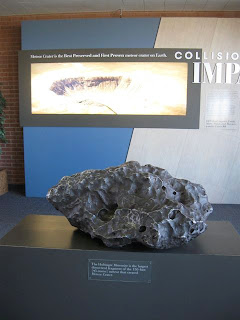 I almost turned back when I discovered that I would have to pay $15.00 to view what is, in essence, a giant hole in the ground. However, how often does one get to see an actual meteor crater? Memories of countless family road trips -- always with an educational component -- were also a factor.
I almost turned back when I discovered that I would have to pay $15.00 to view what is, in essence, a giant hole in the ground. However, how often does one get to see an actual meteor crater? Memories of countless family road trips -- always with an educational component -- were also a factor.The crater was formed about 50,000 years ago, when a 150-foot meteor slammed into the earth. The resulting crater is about 4,000 feet wide and almost 600 feet deep. The impact was so great that part of the meteor was pulverized on impact and part of it was driven some 3,000 feet below the earth's surface.
 The largest surviving fragment of the meteor, the Holsinger meteorite, is on display at the site. It's about the same size as a footlocker and weighs about 1,400 pounds.
The largest surviving fragment of the meteor, the Holsinger meteorite, is on display at the site. It's about the same size as a footlocker and weighs about 1,400 pounds.The crater is not the largest, the oldest, or the most recent, but it is the best preserved owing to the extreme aridity of the Arizona desert.
The crater was an astronaut training site during the 1960s and 1970s, and the small museum at the crater site has a kitschy -- sometimes in a fun way, sometimes in an annoying way -- Space Age look and feel. Most of the information presented in the museum is also conveyed in the 10-minute film that precedes the hour-long tour of the crater itself.
The crater was interesting, and our tour guide was well-informed and funny in a hokey sort of way, but I'm still not sure it was worth the expense. However, the German geologists who were on the tour with me clearly loved it, and anyone else with an abiding interest in geology, astronomy, or space exploration ought to enjoy it.





No comments:
Post a Comment